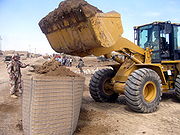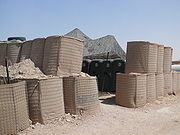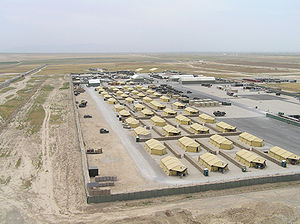
Hesco bastion
Encyclopedia




Gabion
Gabions are cages, cylinders, or boxes filled with soil or sand that are used in civil engineering, road building, and military applications. For erosion control caged riprap is used. For dams or foundation construction, cylindrical metal structures are used...
used for flood control
Flood control
In communications, flood control is a feature of many communication protocols designed to prevent overwhelming of a destination receiver. Such controls can be implemented either in software or in hardware, and will often request that the message be resent after the receiver has finished...
and military fortification
Fortification
Fortifications are military constructions and buildings designed for defence in warfare and military bases. Humans have constructed defensive works for many thousands of years, in a variety of increasingly complex designs...
and the name of the British company that developed it in the late 1980s. It is made of a collapsible wire mesh container and heavy duty fabric liner, and used as a temporary to semi-permanent dike or barrier against blast
Explosion
An explosion is a rapid increase in volume and release of energy in an extreme manner, usually with the generation of high temperatures and the release of gases. An explosion creates a shock wave. If the shock wave is a supersonic detonation, then the source of the blast is called a "high explosive"...
or small-arms
Firearm
A firearm is a weapon that launches one, or many, projectile at high velocity through confined burning of a propellant. This subsonic burning process is technically known as deflagration, as opposed to supersonic combustion known as a detonation. In older firearms, the propellant was typically...
. It has seen considerable use in Iraq
Iraq
Iraq ; officially the Republic of Iraq is a country in Western Asia spanning most of the northwestern end of the Zagros mountain range, the eastern part of the Syrian Desert and the northern part of the Arabian Desert....
and Afghanistan
Afghanistan
Afghanistan , officially the Islamic Republic of Afghanistan, is a landlocked country located in the centre of Asia, forming South Asia, Central Asia and the Middle East. With a population of about 29 million, it has an area of , making it the 42nd most populous and 41st largest nation in the world...
.
Originally designed for use on beaches and marshes for erosion
Erosion
Erosion is when materials are removed from the surface and changed into something else. It only works by hydraulic actions and transport of solids in the natural environment, and leads to the deposition of these materials elsewhere...
and flood control, the HESCO Bastion quickly became a popular security device in the 1990s. Hesco barriers continue to be used for their original purpose. They were used in 2005 to reinforce levees around New Orleans in the few days between Hurricanes Katrina
Hurricane Katrina
Hurricane Katrina of the 2005 Atlantic hurricane season was a powerful Atlantic hurricane. It is the costliest natural disaster, as well as one of the five deadliest hurricanes, in the history of the United States. Among recorded Atlantic hurricanes, it was the sixth strongest overall...
and Rita
Hurricane Rita
Hurricane Rita was the fourth-most intense Atlantic hurricane ever recorded and the most intense tropical cyclone ever observed in the Gulf of Mexico. Rita caused $11.3 billion in damage on the U.S. Gulf Coast in September 2005...
. During the June 2008 Midwest floods
June 2008 Midwest floods
The June 2008 Midwestern United States floods were flooding events which affected portions of the Midwest United States. After months of heavy precipitation, a number of rivers overflowed their banks for several weeks at a time and broke through levees at numerous locations. Flooding continued...
27,000 feet of Hesco barrier wall were shipped to Iowa. In late March, 2009, 35,000 feet of Hesco barrier were delivered to Fargo, North Dakota
Fargo, North Dakota
Fargo is the largest city in the U.S. state of North Dakota and the county seat of Cass County. In 2010, its population was 105,549, and it had an estimated metropolitan population of 208,777...
to fight floods.
Specifically, the brand name for the barrier is 'Concertainer', with 'HESCO Bastion' being the British company that produces it, though the barrier itself is quite generally referred to as a HESCO Bastion, or simply "Hesco".
Development
The HESCO bastion was originally developed by a British entrepreneur named Jimi HeseldenJimi Heselden
James William "Jimi" Heselden OBE was a British entrepreneur. A former coal miner, Heselden made his fortune manufacturing the Hesco bastion barrier system. In 2010, he bought Segway Inc., maker of the Segway personal transport system. Heselden died in 2010 from injuries apparently sustained...
, who in 1989 founded Hesco Bastion Ltd. to manufacture his invention.
Assembly
Assembling the HESCO bastion entails unfolding it and filling it with sand, dirt or gravel - usually using a front end loader. The placement of the barrier is generally very similar to the placement of a sandbag barrier or earth berm except that room must generally be allowed for the equipment used to fill the barrier. The main advantage of HESCO barriers, strongly contributing to their popularity with troops and flood fighters, is the quick and easy setup. Previously, people had to fill sandbags, a slow undertaking, with one worker filling about 20 sandbags per hour. Workers using HESCO barriers and a front end loader can do ten times the work of those using sandbags.The HESCO barriers come in a variety of sizes. Most of the barriers can also be stacked, and they are shipped collapsed in compact sets. Example dimensions of typical configurations are 1.4m x 1.1m x 9.8m (4’6” x 3’6” x 32’) to 2.1m x 1.5m x 30m (7’ x 5’ x 100’).
A new system of HESCO Bastion concertainer developed specially for military use is deployed from a container, which is dragged along the line of ground where the barrier is to be formed, unfolding up to several hundred meters of barrier ready for filling within minutes.
Protection
Filled with sand, 60 centimetres (24 inches) of barrier thickness will stop rifle bullets, shell fragments and other shrapnel. Approximately 1.2 metres (four feet) of thickness provides protection against most car bombCar bomb
A car bomb, or truck bomb also known as a Vehicle Borne Improvised Explosive Device , is an improvised explosive device placed in a car or other vehicle and then detonated. It is commonly used as a weapon of assassination, terrorism, or guerrilla warfare, to kill the occupants of the vehicle,...
s. It takes 1.5 metres (five feet) of thickness to prevent penetration by a rocket-propelled grenade round. In addition, HESCO bastions are even more effective than sandbags against water and rain, which will not compromise the formers' competence.
See also
- Bremer wallBremer wallA Bremer wall is a twelve-foot-high portable, steel-reinforced concrete wall of the type used for blast protection throughout Iraq and Afghanistan. The name is believed to have originated from L...
, steel-reinforced concrete blast walls - GabionGabionGabions are cages, cylinders, or boxes filled with soil or sand that are used in civil engineering, road building, and military applications. For erosion control caged riprap is used. For dams or foundation construction, cylindrical metal structures are used...
, a historic precursor for both erosion control and defense - SandbagSandbagA sandbag is a sack made of hessian/burlap, polypropylene or other materials that is filled with sand or soil and used for such purposes as flood control, military fortification, shielding glass windows in war zones and ballast....
, the low-tech precursor / alternative
External links
- Hesco Bastion Ltd (homepage of the 'Hesco' manufacturer)
- Hesco FaceBook page

